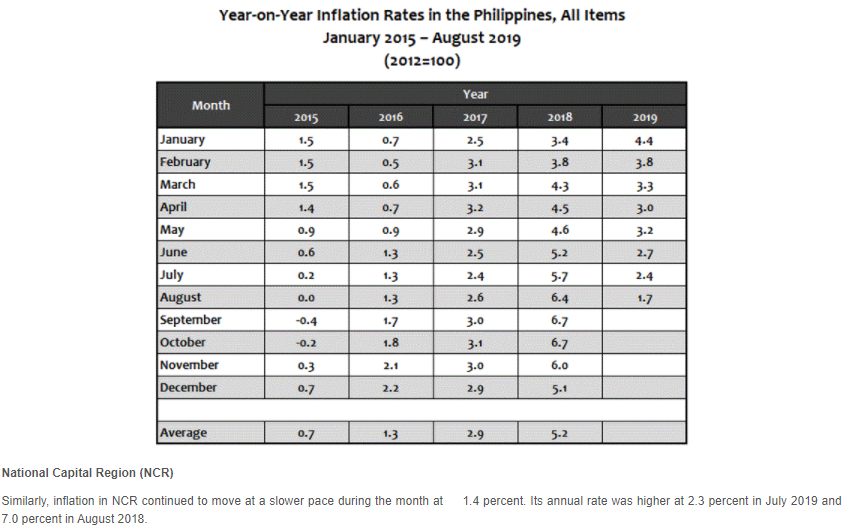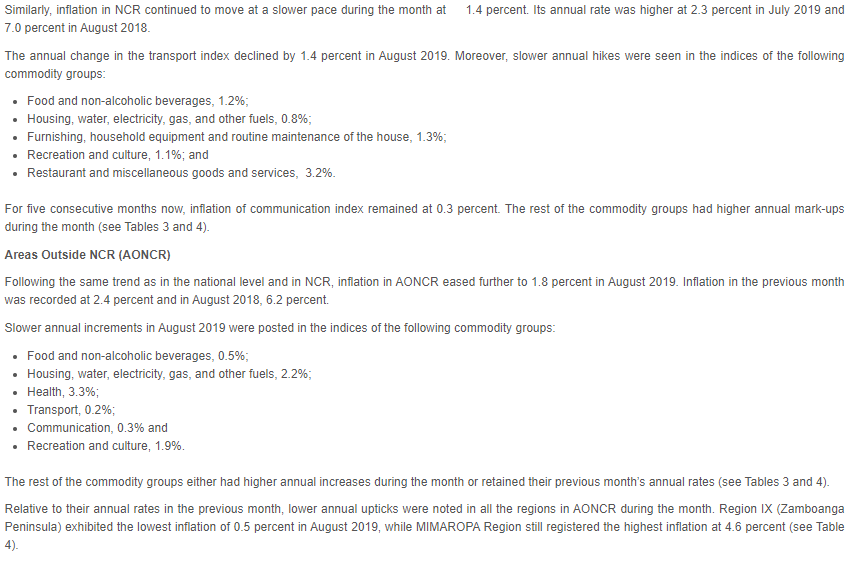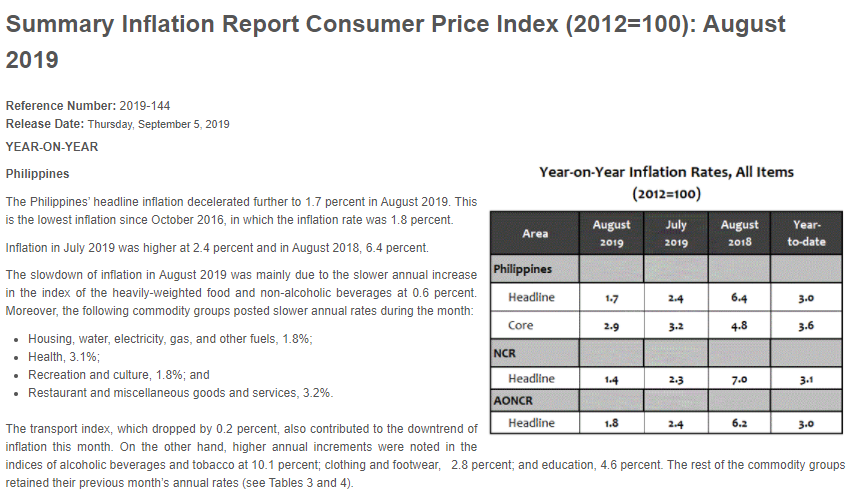

Please help me to interpret the results of this index report. Just interpret the results and explain what it means. Thank you.
https://psa.gov.ph/statistics/survey/price/summary-inflation-report-consumer-price-index-2012100-august-2019
Summary Ination Report Consumer Price Index (2012=100): August 2019 Reference Number: 2019-144 Release Date: Thulsdav, September 5. 2019 YEAR-DN-YEAR Philippines Year-on-'rear Ination Rates, All Items amenco} The Philippines' headline inflation decelerated furtherto 1.? percent in August 2019. This is the lowest ination since October 2015, in which the ination rate was 1.8 percent. Ination in July 2019was higher at 2.4 percent and in August 2013, 6.4 percent. The slowdown of ination in August 2019 was mainly due to the slower annual increase in the index of the heavilyweighted food and nonalcoholic beverages at 0.5 percent. Moreover, the following commodity groups posted slower annual rates during the month: - Housing, water, eiectn'citv, gas, and other fuels, 1.3%; . Health, 3.1%; - Recreation and culture, 1.3%; and . Restaurant and miscellaneous goods and services, 3.2%. The transport index, which dropped by 0.2 percent, also contributed to the downtrend of inflation this month. On the other hand, higher annual increments were noted in the indices of alcoholic beverages and tobacco at 10.1 percent; clothing and footwear, 2.3 percent; and education. 4.5 percent. The rest of the commodity groups retained their previous month's annual rates (see Tables 3 and 4). Excluding selected food and energy items, core ination, likewise, eased further to 2.9 percent in August 2019. In JulyI 2019, core ination was registered at 3.2 percent and in August 2018, 4.8 percent {seeTahle 9]. ""\"' """' " ' "'' " ' ' '\""' Ination of the country's food index slowed down to I13 percent during the month. Its annual rate in Juli.' 2019 was higher at 1.? percent, and in August 2013, 8.2 percent {see Table I"). Annual declines were noted in the indices of rice at -5.2 percent; corn, -3.? percent; vegetables, -1.4 percent; and sugar, jam, honey, chocolate and confectionenr, -2.9 percent In addition, annual upticios were slower in the following lood groups: . Other cereals, flour, cereal preparation, bread, pasta and other bakery,r products, 3.2%; . Meat, 2.5%; . Fish, 2.8%; - Oils and tats, 1.8%; and . Food products, not elsewhere classied, 6.6%. On the contrary, annual increases in the indices of mill-t, cheese and egg; and fruits were higherat 2.? percent and 14 percent, respectively (see Table 5). Year-on-Year Inflation Rates in the Philippines, All Items January 2015 - August 2019 (2012=100) Year Month 2015 2016 2017 2018 2019 January 1.5 0.7 2.5 3.4 4.4 February 1.5 0.5 3-1 3.8 3.8 March 1.5 0.6 3.1 4-3 3-3 April 1.4 0.7 3.2 4-5 3.0 May 0.9 0.9 2.9 4.6 3-2 June 0.6 1.3 2.5 5-2 2.7 July 0.2 1.3 2.4 5-7 2.4 August 0.0 1.3 2.6 6.4 1.7 September -0.4 1.7 3.0 6.7 October -0.2 1.8 3.1 6.7 November 0.3 2.1 3.0 6.0 December 0.7 2.2 2.9 5-1 Average 0.7 1.3 2.9 5-2 National Capital Region (NCR) Similarly, inflation in NCR continued to move at a slower pace during the month at 1.4 percent. Its annual rate was higher at 2.3 percent in July 2019 and 7.0 percent in August 2018.Similarly, inflation in NCR continued to move at a slower pace during the month at 1.4 percent. Its annual rate was higher at 2.3 percent in July 2019 and 7.0 percent in August 2018. The annual change in the transport index declined by 1.4 percent in August 2019. Moreover, slower annual hikes were seen in the indices of the following commodity groups: Food and non-alcoholic beverages, 1.2%; Housing, water, electricity, gas, and other fuels, 0.8%; Furnishing, household equipment and routine maintenance of the house, 1.3%; Recreation and culture, 1.1%; and . Restaurant and miscellaneous goods and services, 3.2%. For five consecutive months now, inflation of communication index remained at 0.3 percent. The rest of the commodity groups had higher annual mark-ups during the month (see Tables 3 and 4). Areas Outside NCR (AONCR) Following the same trend as in the national level and in NCR, inflation in AONCR eased further to 1.8 percent in August 2019. Inflation in the previous month was recorded at 2.4 percent and in August 2018, 6.2 percent. Slower annual increments in August 2019 were posted in the indices of the following commodity groups: Food and non-alcoholic beverages, 0.5%; Housing, water, electricity, gas, and other fuels, 2.2%; Health, 3.3%; Transport, 0.2%; Communication, 0.3% and Recreation and culture, 1.9%. The rest of the commodity groups either had higher annual increases during the month or retained their previous month's annual rates (see Tables 3 and 4). Relative to their annual rates in the previous month, lower annual upticks were noted in all the regions in AONCR during the month. Region IX (Zamboanga Peninsula) exhibited the lowest inflation of 0.5 percent in August 2019, while MIMAROPA Region still registered the highest inflation at 4.6 percent (see Table 4)












